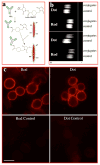Semiconductor quantum rods as single molecule fluorescent biological labels
- PMID: 17212460
- PMCID: PMC3984543
- DOI: 10.1021/nl0626434
Semiconductor quantum rods as single molecule fluorescent biological labels
Abstract
In this paper, we report the development of rod-shaped semiconductor nanocrystals (quantum rods) as fluorescent biological labels. Water-soluble biocompatible quantum rods have been prepared by surface silanization and applied for nonspecific cell tracking as well as specific cellular targeting. Quantum rods are brighter single molecule probes as compared to quantum dots. They have many potential applications as biological labels in situations where their properties offer advantages over quantum dots.
Figures



References
-
- Nam J, Thaxton CS, Mirkin CA. Science. 2003;301:1884–1886. - PubMed
-
- Sonnichsen C, Reinhard BM, Liphardt J, Alivisatos AP. Nature Biotechnology. 2005;23(6):741–745. - PubMed
-
- Turner JL, Pan D, Plummer R, Chen Z, Whittaker AK, Wooley KL. Advanced Functional Materials. 2005;15(8):1248–1254.
-
- Jun YW, HYM, Choi JS, Lee JH, Song HT, Kim S, Yoon S, Kim KS, Shin JS, Suh JS, Cheon J. J Am Chem Soc. 2005;127:5732–5733. - PubMed
-
- Alivisatos AP, Gu W, Larabell C. Ann Rev Biomed Eng. 2005;7:55–76. - PubMed
Publication types
MeSH terms
Substances
Grants and funding
LinkOut - more resources
Full Text Sources
Other Literature Sources

